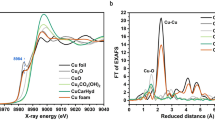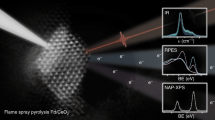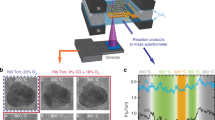Abstract
The coarsening of catalytically active metal clusters is often accelerated by the presence of gases, but the role played by gas molecules is difficult to ascertain and varies from system to system1,2,3,4,5,6,7,8. We use scanning tunnelling microscopy to follow the CO-induced coalescence of Pd adatoms supported on the Fe3O4(001) surface at room temperature, and find Pd-carbonyl species to be responsible for mobility in this system. Once these reach a critical density, clusters nucleate; subsequent coarsening occurs through cluster diffusion and coalescence. Whereas CO induces the mobility in the Pd/Fe3O4 system, surface hydroxyls have the opposite effect. Pd atoms transported to surface OH groups are no longer susceptible to carbonyl formation and remain isolated. Following the evolution from well-dispersed metal adatoms into clusters, atom-by-atom, allows identification of the key processes that underlie gas-induced mass transport.
This is a preview of subscription content, access via your institution
Access options
Subscribe to this journal
Receive 12 print issues and online access
$259.00 per year
only $21.58 per issue
Buy this article
- Purchase on Springer Link
- Instant access to full article PDF
Prices may be subject to local taxes which are calculated during checkout




Similar content being viewed by others
References
Thiel, P. A., Shen, M., Liu, D-J. & Evans, J. W. Adsorbate-enhanced transport of metals on metal surfaces: Oxygen and sulfur on coinage metals. J. Vac. Sci. Technol. A 28, 1285–1298 (2010).
Ling, W. L. et al. Enhanced self-diffusion on Cu(111) by trace amounts of S: Chemical-reaction-limited kinetics. Phys. Rev. Lett. 93, 166101 (2004).
Feibelman, P. J. Formation and diffusion of S-decorated Cu clusters on Cu(111). Phys. Rev. Lett. 85, 606–609 (2000).
Harris, P. J. F. Growth and structure of supported metal catalyst particles. Int. Mater. Rev. 40, 97–115 (1995).
Bartholomew, C. H. Mechanisms of catalyst deactivation. Appl. Catal. A 212, 17–60 (2001).
Chaâbane, N., Lazzari, R., Jupille, J., Renaud, G. & Avellar Soares, E. CO-induced scavenging of supported Pt nanoclusters: A GISAXS study. J. Phys. Chem. C 116, 23362–23370 (2012).
Simonsen, S. B. et al. Direct observations of oxygen-induced platinum nanoparticle ripening studied by in situ TEM. J. Am. Chem. Soc. 132, 7968–7975 (2010).
Rasmussen, D. B. et al. The energies of formation and mobilities of Cu surface species on Cu and ZnO in methanol and water gas shift atmospheres studied by DFT. J. Catal. 293, 205–214 (2012).
Campbell, C. T., Parker, S. C. & Starr, D. E. The effect of size- dependent nanoparticle energetics on catalyst sintering. Science 298, 811–814 (2002).
Moulijn, J. A., van Diepen, A. E. & Kapteijn, F. Catalyst deactivation: is it predictable? What to do? Appl. Catal. A 212, 3–16 (2001).
Wynblatt, P. & Gjostein, N. A. Supported metal crystallites. Prog. Solid State Chem. 9, 21–58 (1975).
Brown, M. A. et al. Oxidation of Au by surface OH: Nucleation and electronic structure of gold on hydroxylated MgO(001). J. Am. Chem. Soc. 133, 10668–10676 (2011).
Starr, D., Shaikhutdinov, S. & Freund, H-J. Gold supported on oxide surfaces: Environmental effects as studied by STM. Top. Catal. 36, 33–41 (2005).
Pereira, E. B. & Martin, G-A. Morphology changes and deactivation of alkali-promoted Ni/SiO2 catalysts during carbon monoxide hydrogenation. Appl. Catal. A 115, 135–146 (1994).
Horch, S. et al. Enhancement of surface self-diffusion of platinum atoms by adsorbed hydrogen. Nature 398, 134–136 (1999).
Jak, M. J. J., Konstapel, C., van Kreuningen, A., Verhoeven, J. & Frenken, J. W. M. Scanning tunnelling microscopy study of the growth of small palladium particles on TiO2(110). Surf. Sci. 457, 295–310 (2000).
Challa, S. R. et al. Relating rates of catalyst sintering to the disappearance of individual nanoparticles during Ostwald ripening. J. Am. Chem. Soc. 133, 20672–20675 (2011).
Datye, A. K., Xu, Q., Kharas, K. C. & McCarty, J. M. Particle size distributions in heterogeneous catalysts: What do they tell us about the sintering mechanism? Catal. Today 111, 59–67 (2006).
Yang, F., Chen, M. S. & Goodman, D. W. Sintering of Au particles supported on TiO2(110) during CO oxidation. J. Phys. Chem. C 113, 254–260 (2008).
Novotný, Z. et al. Ordered array of single adatoms with remarkable thermal stability: Au/Fe3O4(001). Phys. Rev. Lett. 108, 216103 (2012).
Pentcheva, R. et al. Jahn–Teller stabilization of a ‘polar’ metal oxide surface: Fe3O4(001). Phys. Rev. Lett. 94, 126101 (2005).
Parkinson, G. S., Novotny, Z., Jacobson, P., Schmid, M. & Diebold, U. Room temperature water splitting at the surface of magnetite. J. Am. Chem. Soc. 133, 12650–12655 (2011).
Parkinson, G. S. et al. Semiconductor-half metal transition at the Fe3O4(001) surface upon hydrogen adsorption. Phys. Rev. B 82, 125413 (2010).
Lodziana, Z. Surface Verwey transition in magnetite. Phys. Rev. Lett. 99, 206402 (2007).
Xu, L., Henkelman, G., Campbell, C. T. & Jónsson, H. Small Pd clusters, up to the tetramer at least, are highly mobile on the MgO(100) surface. Phys. Rev. Lett. 95, 146103 (2005).
Starr, D. E. et al. Heat of adsorption of Cu and Pb on hydroxyl-covered MgO(100). Surf. Sci. 515, 13–20 (2002).
Novotny, Z. et al. Probing the surface phase diagram of Fe3O4(001) towards the Fe-rich limit: Evidence for progressive reduction of the surface. Phys. Rev. B 87, 195410–195417 (2013).
Blaha, P., Schwarz, K., Madsen, G. K. H., Kvasnicka, D. & Lutz, J. WIEN2k, an Augmented Plane Wave+Local Orbitals Program for Calculating Crystal Properties (Karlheinz Schwarz, Techn. Univ. Wien, Austria, 2001).
Perdew, J. P., Burke, K. & Ernzerhof, M. Generalized gradient approximation made simple. Phys. Rev. Lett. 77, 3865–3868 (1996).
Anisimov, V. I., Solovyev, I. V., Korotin, M. A., Czyayk, M. T. & Sawatzky, G. A. Density-functional theory and NiO photoemission spectra. Phys. Rev. B 48, 16929 (1993).
Acknowledgements
This material is based on work supported as part of the Center for Atomic-Level Catalyst Design, an Energy Frontier Research Center funded by the US Department of Energy, Office of Science, Office of Basic Energy Sciences under Award Number #DE-SC0001058. The authors acknowledge Z. Mao and T. J. Liu (Tulane University) for the synthetic sample used in this work. G.S.P. acknowledges support from the Austrian Science Fund project number P24925-N20. R.K. and J.P. acknowledge stipends from the TU Vienna doctoral college CATMAT.
Author information
Authors and Affiliations
Contributions
G.S.P. designed the experiments, analysed data and wrote the paper; Z.N., G.A. and J.P. performed the experiments and analysed data; R.K. and P.B. performed and analysed the theoretical calculations; M.S. and U.D. designed the experiments and wrote the paper.
Corresponding authors
Ethics declarations
Competing interests
The authors declare no competing financial interests.
Supplementary information
Supplementary Information
Supplementary Information (PDF 645 kb)
Supplementary Information
Supplementary Movie S1 (MOV 347 kb)
Supplementary Information
Supplementary Movie S2 (MOV 532 kb)
Rights and permissions
About this article
Cite this article
Parkinson, G., Novotny, Z., Argentero, G. et al. Carbon monoxide-induced adatom sintering in a Pd–Fe3O4 model catalyst. Nature Mater 12, 724–728 (2013). https://doi.org/10.1038/nmat3667
Received:
Accepted:
Published:
Issue Date:
DOI: https://doi.org/10.1038/nmat3667
This article is cited by
-
Dynamic and reversible transformations of subnanometre-sized palladium on ceria for efficient methane removal
Nature Catalysis (2023)
-
Reverse oxygen spillover triggered by CO adsorption on Sn-doped Pt/TiO2 for low-temperature CO oxidation
Nature Communications (2023)
-
Advances in heterogeneous single-cluster catalysis
Nature Reviews Chemistry (2023)
-
Study of CO molecules on Pd/Al2O3/NiAl(110) surface by atomic force microscopy and Kelvin probe force microscopy
Journal of Nanoparticle Research (2023)
-
Evolution of Surface Structure on Pd–Cl/Alumina Catalyst During CO Purification Process
Catalysis Letters (2023)



